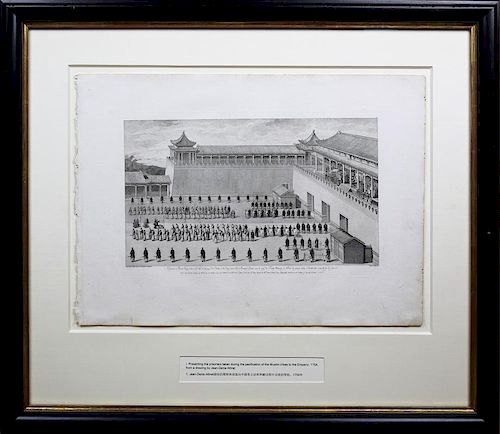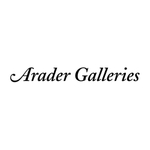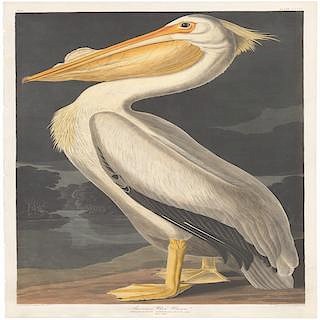Qianlong & Helman, Engravings of Battle Scenes, 18th Century
Lot 174
About Seller
Arader Galleries
1308 Walnut Street
King of Prussia, PA 19406
United States
Arader Galleries proudly celebrates over 40 years in the business of important, antique works on paper, paintings and rare books. W. Graham Arader III began his collection of rare maps, atlases and Americana while an undergraduate at Yale University, and today that passion has grown into one of the ...Read more
Estimate:
$60,000 - $80,000
Absentee vs Live bid
Two ways to bid:
- Leave a max absentee bid and the platform will bid on your behalf up to your maximum bid during the live auction.
- Bid live during the auction and your bids will be submitted real-time to the auctioneer.
Bid Increments
| Price | Bid Increment |
|---|---|
| $0 | $25 |
| $500 | $50 |
| $1,000 | $100 |
| $2,000 | $250 |
| $5,000 | $500 |
| $10,000 | $1,000 |
| $20,000 | $2,000 |
| $50,000 | $5,000 |
| $100,000 | $10,000 |
| $200,000 | $25,000 |
About Auction
By Arader Galleries
Mar 25, 2017 - Mar 26, 2017
Set Reminder
2017-03-25 13:00:00
2017-03-26 13:00:00
America/New_York
Bidsquare
Bidsquare : Arader Galleries Spring 2017 Auction
https://www.bidsquare.com/auctions/arader/arader-galleries-spring-2017-auction-2184
Arader Galleries loricohen@aradergalleries.com
Arader Galleries loricohen@aradergalleries.com
- Lot Description
Suite des seize estampes representant les Conquetes de l’empereur de la Chine, avec leur explication. QIANLONG, Emperor of China - HELMAN, Isidore Stanislas (1743-1806?). Paris: chez l’Auteur, [1783-1788]. The series depicts the battles, victories and ceremonies of the Chinese Emperor Qianlong, emperor of the Qing dynasty (1644-1911), who ruled from 1735 to 1796. Second and enlarged edition, first French issue, preceded by a Chinese issue with only sixteen engravings, printed in France. This later series depicts the battles, victories and ceremonies of the Chinese Emperor Qianlong, emperor of the Qing dynasty (1644-1911), who ruled from 1735 to 1796. The original set of sixteen engravings depict his 1772-1776 military campaign, led by General A-Kuei, against the Jinchuan tribes in China’s inner provinces and along the country’s frontiers in the ethnically-Tibetan mountain regions of Szechuan, and were commissioned on the 13th of July 1765. The templates for the first series of engravings were large paintings by European missionary artists employed at that time at the court in Beijing: Italian Jesuit Giuseppe Castiglione (1688-1766), French Jesuit Jean-Denis Attiret (1702-1768), Bohemian Jesuit Ignatius Sichelbarth (1708-1780), and the Italian Augustinian missionary, Jean-Damascene Sallusti (d. 1781), after originals by Chun-ko-erh Hui-pu teng chu te sheng tu (1769-1774). The paintings were sent to France where the engravings for the first series of sixteen were executed in Paris, in the style of the Augsburg copper engraver Georg Philipp Rugendas the Elder (1666-1742), under the direction of Charles-Nicolas Cochin of the Academie Royale at the court of Louis XVI. These engravings were printed in 1774 and distributed in China, with only a few rare proofs remaining in Europe. Such was the French interest in Qianlong so great that Helman (a pupil of J.P. le Bas who had worked on the first series of plates) published reduced versions, as here, with captions in French, between 1783 and 1785. He added eight further plates depicting imperial ceremonies between 1786 and 1788, with an additional leaf of engraved labels for prints 1-18. Qianlong’s ‘Battle Copper Prints’ were just one of the means the Manchu emperor employed to document his campaigns of military expansion and suppression of regional unrest. They served to glorify his rule and to exert ideological control over Chinese historiography. In the history of Chinese art, copper-print engraving remained an episode. Seen in their political context, the Qianlong prints represent a distinct and exceptional pictorial genre and are telling examples of the self-dramatization of imperial state power. Later campaigns of Qianlong which were similarly commemorated include Taiwan (1786-1788), Annam or Vietnam (1788), Gurkhas invasion of Tiber (1790), and Yunnan, Guizhou and Hunan (1795-1796). Cordier 642; Lust 1131; Shiqu Baoji, Imperial Catalogue; Chuang Chi-fa, Taipei Palace Museum - Ten Military Campaigns ofQianlong Emperor; W. Fuchs, in Monumenta Serica, 4 (1939-40), 122; Paul Pelliot, ‘Les ‘Conquetes de l’Empereur de la Chine’’, in Toung pao, 20 (1921), pp. 183-274; S. L. Shaw, Imperial printing, p. 22; Takata Tokio, ‘QianlongEmperor’s Copperplate Engravings of the ‘Conquest of Western Regions,’ The Memoirs of the Tokyo Bunko, 70, 2012.
- Shipping Info
-
Shipping Terms:Packing and handling of purchased lots by us or by someone else is at the entire risk of the purchaser. Purchasers are responsible for all packing and shipping costs.
We are not responsible for the acts or omissions of carriers or packers of purchased lots whether or not recommended by us.
-
- Buyer's Premium



 EUR
EUR CAD
CAD AUD
AUD GBP
GBP MXN
MXN HKD
HKD CNY
CNY MYR
MYR SEK
SEK SGD
SGD CHF
CHF THB
THB







